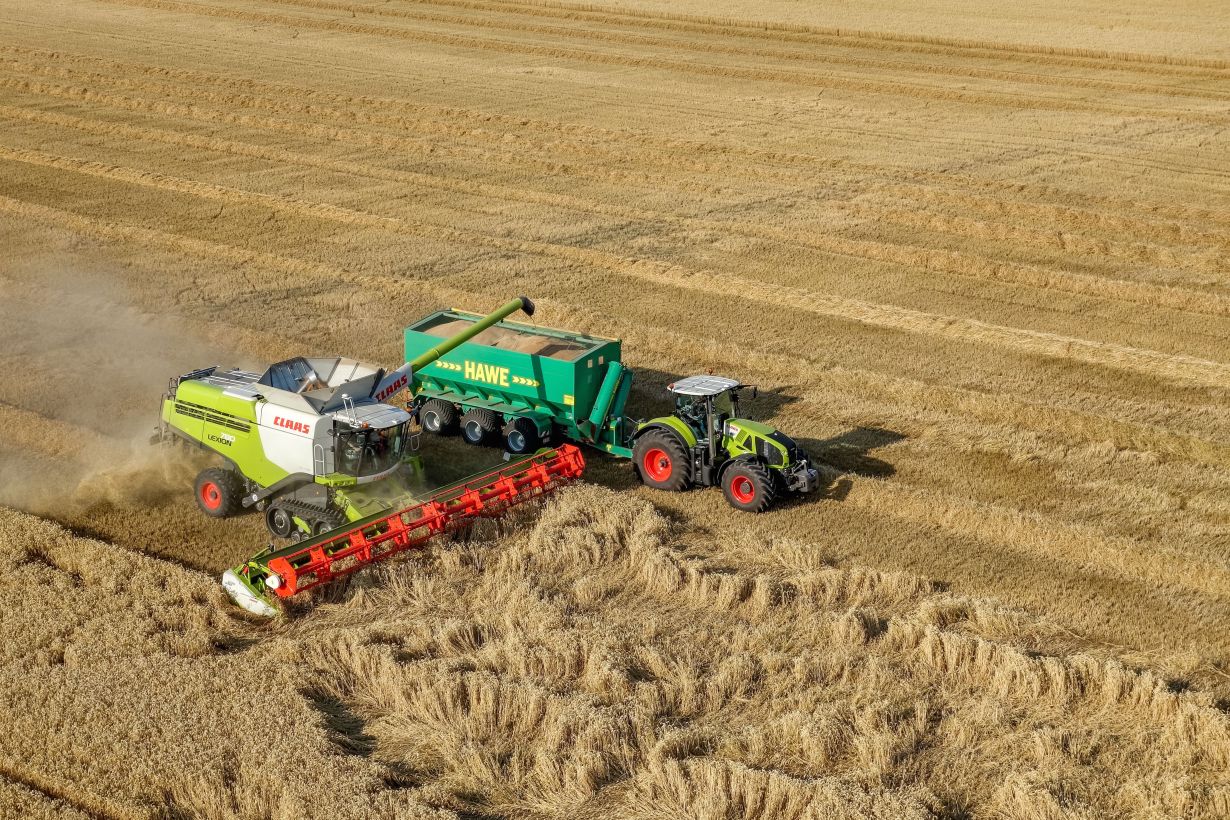Cereals – for the production of foodstuff and animal feed – are the main source of income in agriculture, along with meat and vegetables. The most important cereal in German farming is wheat, with a cultivation area of around 3.1 million hectares in 2019. Despite the use of ultra-modern machines, there are phases of harvesting with very high and with relatively low workloads. Researchers of the Karlsruhe Institute of Technology (KIT) are developing an automated assistance system that – based on the driver’s current level of stress and workload – can provide recommendations for action, thus providing a better balance and increasing overall well-being.
During harvesting, a combine harvester performs a combination of several work steps: It picks up the grain via the cutterbar header and conveys it to the threshing unit where it is threshed. The threshed material is then cleaned and goes into the grain tank from where it is finally transported away. Intelligent and networked systems are already shaping today’s agricultural life: Almost 82 percent of the German farmers use digital technologies. “Agricultural harvesters with a high degree of automation are already able to perform many procedures independently, using GPS steering systems, sensors, or farming and management systems,” says Patrick Lehr from the Mobile Machines (Mobima) section of the KIT Institute of Vehicle System Technology (FAST). “Thanks to such systems, time spent on the combine harvester can also be used to take care of other things, such as management tasks.”

Spread over the day of harvest – which is often more than ten hours long – periods of high and comparatively low workload alternate: “Various studies have shown that people feel most comfortable at a medium level of stress,” explains Patrick Lehr. This is where the researchers from Mobima and the Institute of Human and Industrial Engineering (ifab) come in. They are currently developing an assistance system that recommends tasks to drivers depending on their current level of stress. “Useful extra tasks for phases of low stress or workload involve accounting, staff or material management as well as the private sector. Otherwise, these would have to be completed after the field work is done,” explains Patrick Lehr. “On the other hand, maximum attention is required when the driver starts threshing in a new field. In this moment, it is important to disregard any irrelevant information.” In this way, the system counteracts situations of excessive and insufficient stress and ensures that the driver remains attentive.
Intelligent systems detect the stress level
The novel driver's cab consists of several subsystems. The main objective is to recognize how much stress the driver is currently under. In studies, researchers from ifab evaluate the driver’s current state of stress by means of eye tracking. A fitness wristband that uses light signals to determine the pulse rate and can thus measure the stress level is also conceivable. “With this input, we are then able to make recommendations for action,” explains Patrick Lehr. In future, these will be projected into the driver's field of vision via an interface based on Augmented Reality (AR). Thus, the cab will not be overloaded with controls.
According to Patrick Lehr, this man-machine interface, which adapts to the driver’s level of stress, has ecological, economic, and social advantages. Since the driver's cab is digitally connected, it integrates useful information for harvesting, such as weather forecasts or data on soil contamination. “Last but not least, this innovative technical system can also contribute to making the workplace and the job profile more attractive,” explains Patrick Lehr.
The Mobima workgroup first collected all requirements and drew up concepts for the individual subsystems and then started developing practical technical solutions that capture the driver's condition and enable interaction. For this purpose, the system is tested in a demonstrator. In a separate test for condition assessment, the researchers measure the stress limit of test persons by having them perform a main task in the field, such as threshing, and then optionally an additional management task. In order to be able to include the wishes and needs of the farmers directly, the team interviewed farm managers, drivers, and agricultural service providers beforehand. “The majority could imagine to use the time when the combine harvester is working automatically for other tasks in the future. Many of them especially mentioned the increasingly important duty of documentation,” says Patrick Lehr.
The investigations of the KIT scientists are part of a joint project called “Fahrerkabine 4.0: Entwicklung einer beanspruchungs-adaptiven Nutzerschnittstelle für Landmaschinenbetreiber” (Driver's Cab 4.0: Development of a workload-adaptive user interface for agricultural machinery operators). This project is funded by the German Federal Ministry of Education and Research with a total of three million euros – of which KIT will receive about 1.4 million. Other project participants are the University of Hohenheim, the start-up R3DT, the companies InMach, Budde Industrie Design, and CLAAS, the European market leader in harvesting machines.

Being “The Research University in the Helmholtz Association”, KIT creates and imparts knowledge for the society and the environment. It is the objective to make significant contributions to the global challenges in the fields of energy, mobility, and information. For this, about 10,000 employees cooperate in a broad range of disciplines in natural sciences, engineering sciences, economics, and the humanities and social sciences. KIT prepares its 22,800 students for responsible tasks in society, industry, and science by offering research-based study programs. Innovation efforts at KIT build a bridge between important scientific findings and their application for the benefit of society, economic prosperity, and the preservation of our natural basis of life. KIT is one of the German universities of excellence.

